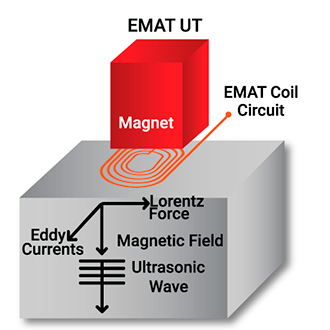Our non-destructive testing (NDT) for in-service solutions and resolution of issues use specialist diagnostic equipment based on the application of electromagnetic transducers (EMATs) and medium range ultrasound (MRUT) technologies.
What is electromagnetic transducers (EMATs) technology?

Electromagnetic transducers (EMATs) are a form of ultrasonic testing (UT) that generates sound in the asset or component being inspected rather than the transducer. EMATs produce ultrasonic waves in a test subject by using electromagnetic induction with two interacting magnetic fields. A relatively high frequency (RF) field generated by electrical coils, interacts with a low frequency or static field generated by magnets, in a similar way to an electric motor, to produce a Lorentz force (i.e., the entire electromagnetic force on the charged particle moving with velocity through an electric and a magnetic field, named after the Dutch physicist Hendrik A Lorentz).
The arising disturbance is transferred to the matrix of the material, producing an elastic wave. In a reciprocal process, the interaction of elastic waves in the presence of a magnetic field induces currents in the receiving EMAT coil circuit. A liquid couplant is not required because the sound is generated in the part inspected instead of the transducer.
EMATs have distinct advantages for in-situ application, over more conventional inspection techniques, as they are completely non-contact.
What is medium range ultrasound (MRUT) technology?
Medium range ultrasound (MRUT) technology, used in both attenuation and reflection mode, is one of the most common methods for in-service inspection, with sensors mounted on scanners to inspect of long stretches of pipe or tank. MRUT uses high frequency guided waves from 100kHz to 1MHz. It has a typical inspection range of 4” (0.1m) to 16” (5m) and is around ten times more sensitive than long range ultrasound (LRUT). Therefore, it can detect corrosion, cracks, small flaws such as pits and inconsistencies on exposed tubes, gas lines, oil pipeline, and storage tanks.
Scanning can be achieved with 100% coverage at speeds of up to 150mm/s, on pipe diameters from 2.0” (50mm) to 46.0” (1168mm). Inspections can also be performed on rough, corroded surfaces covered with thin wraps or coatings (<3mm).
